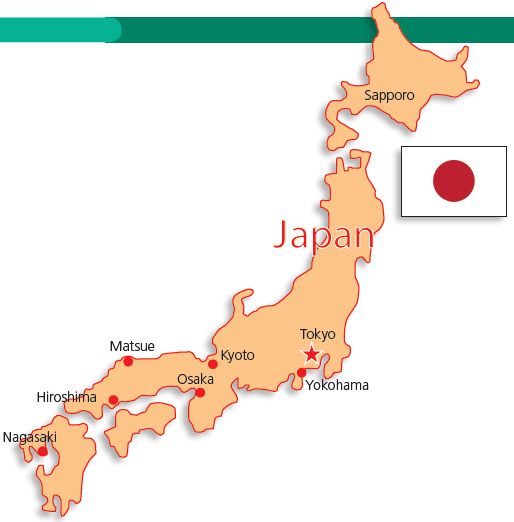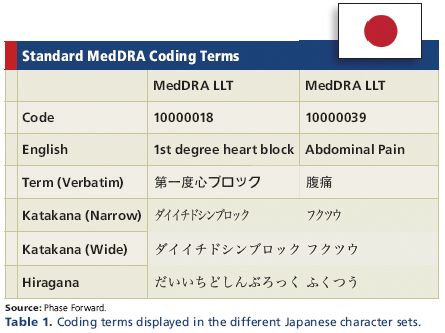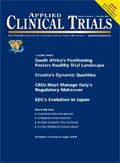EDC Acceptance in Japan
While it has yet to be fully integrated, electronic data capture is gaining ground in Japan.
Over the last several years, the Japanese government, in conjunction with its national pharmaceutical industry, has embarked upon an ambitious program to update the country's clinical development procedures to bring them in line with global best practices.

The results thus far have been striking, as the latest pharmaceutical standards have been adopted by the national regulatory agency, and electronic data capture use in clinical trials—a key hallmark of modernization—has dramatically increased. Japan, once lagging behind its regional competitors, has reemerged as a force in the Asia-Pacific drug development market.

When discussing the future of clinical trials in Asia, the prospects of China and India elicit much enthusiasm. The advantages that these two countries offer are well documented, but the Asia-Pacific region overall represents an enormous opportunity for the biopharmaceutical industry. The medical infrastructure throughout the region is excellent and clinicians and site investigators, while limited in some countries, are well educated. Data generated in clinical studies have met high Western standards and have been submitted to numerous regulatory agencies, including the FDA, MHRA, and EMEA.
And while it is easy to focus on the vast potential of India and China, Japan has been rapidly updating its trial practices to great success. Over the past few years, Japan has outpaced all other Asian countries in increasing the rate of new clinical trials starts, according to a 2008 CenterWatch report1 and FDA analysis.
With the world's second largest economy, Japan already enjoys many advantages over its aspiring neighbors, and as the clinical development industry in Asia matures, the country could find itself the leader of the Asia-Pacific clinical trial market. This is certainly not a foregone conclusion, however, as Japan has multiple barriers in how it conducts clinical trials that must still be overcome.
Importance of going global
Globalizing clinical development activities is vital for successful pharmaceutical companies in the 21st century. It increases speed to market by opening up diverse new populations for recruitment—including treatment naïve patients—and lowers the overall cost of conducting trials. And yet, until recently, Japan has been reticent to allow clinical data generated entirely outside the country to be included in regulatory submissions.
Although ICH standard GCP guidance has been in place in Japan since 1997, the country has been slow to adopt global clinical processes, infrastructure, and methodologies to increase efficiency. This, along with many cultural complexities, has led many pharmaceutical companies to bypass Japan when selecting global trial sites and has also led to a performance gap between Japanese sites and many global sites.
Japan is the second largest pharmaceutical market in the world with approximately $60 billion in sales annually. And yet, despite its market size, it typically takes 2.5 years longer for a drug to come to market in Japan than in the United States, according to the Japan's Pharmaceutical and Medical Device Agency (PMDA).2 This lag generates a great deal of discussion about loss of sales, but more importantly this prevents Japanese patients from receiving the most up-to-date treatments, and has sparked government action to correct the problem.
A relatively conservative regulatory environment has led to conventional requirements forcing sites and sponsors to adopt out-dated site monitoring, data management, and reporting policies. In response to a government-sponsored survey that outlined the performance gap, the Japanese regulatory authority, the Ministry of Health, Labour and Welfare (MHLW), has recently begun to accept truly global trials and the supporting technology necessary for their success.
In 2007, the MHLW initiated the New Five Year Clinical Trial Activation Plan in an effort to standardize drug development practices and speed the time it takes to bring a drug to market.3 This government-subsidized plan resulted in a massive infrastructure investment to revitalize the nation's drug development industry. Site personnel were trained in managing global pharma protocols, and the MHLW enacted improved reporting and submission standards, including allowing trial subject data generated outside the country to be included in submissions. The agency is also researching electronic data capture (EDC) technology and its role in national health care.
Application of EDC
The use of EDC in Japanese clinical sites was spiking before the government embarked upon its clinical development modernization scheme. Japanese affiliate offices in the United States and Europe, where EDC has become the preferred method for capturing and managing trial data, were driving EDC back into the headquarter offices in Japan. Because of the success of EDC in the affiliate offices and in the West in general, Japanese headquarters have been forced to embrace this technology. This bottom-up EDC adoption model is a very different paradigm than the typical top-down European and U.S. precedents.
There have been challenges to implementing EDC in Japan. Despite English being widely taught in the country's schooling system, few people have the opportunities in the work environment to become proficient in the language. Therefore, it is vital to conduct trials in Japanese to ensure data accuracy and increase overall acceptance of the technology. Global clinical trials using English in Japan impose preselection of sites with high levels of English competence. This quickly limits the scope of a study.
In particular, later-phase trials requiring large patient populations necessitate the use of smaller sites outside of the major cities where site staff often do not speak English. If a principal investigator or a Clinical Research Associate (CRA) is needed to translate any study documentation or data queries into English, it will place an undue time and cost burden on the trial. Likewise, the other option of quick Japanese-to-English translation guides (i.e., cheat sheets) to input data slows the overall trial pace, creating further overheads on the study.
To address the language barrier challenges and encourage adoption in Japan, many EDC software vendors have added support for a Japanese user interface to make it easier for Japanese sites to collect clinical trial data electronically. However, many Japanese sponsors have realized it is not enough to be able to just capture data in a specific language. EDC solutions also need to efficiently support the processes for building, cleaning, and submitting data for any regionally based or multilanguage trial. For EDC software, capturing data electronically is relatively straightforward; the challenge is recognizing the variety of language character sets to be able to efficiently code adverse event terms and concomitant medications to common industry standard terms. This is a critical requirement for analysis.
The Japanese language has three different sets of characters: Kanji, Katakana, and Hiragana (four if you count Romaji). As Table 1 shows, each of these character sets are of different widths and sizes, which complicates incorporation into Unicode—a computing industry standard allowing computers to consistently represent and manipulate text.

The latest EDC technologies offer comprehensive data management and coding tools to address this complex challenge. The new solutions provide a single environment that allows sponsors to streamline design time and clean, code, and submit clinical trial data all within a single environment for use in regional or multilanguage global trials. All of which should significantly support EDC adoption in Japan.
Other considerations
The consensus-driven nature of the Japanese business climate seeks approval from all stakeholders before any major new initiative is implemented, which can prolong the EDC adoption process. The robust global support structure in place at EDC providers, however, can overcome some of this hesitation. Always available help desks manned by Japanese nationals rather than nonnative Japanese speakers are a great comfort to local organizations, as they can manage the cultural idiosyncrasies.
eLearning training modules conducted in Japanese can also quickly raise EDC proficiency levels for large numbers of users, which is particularly useful at investigator sites where the number of users is typically much higher than found in the West. With well-trained site staff and a support network in place, organizations quickly see the advantage of applying EDC technology.
Traditional EDC models have somewhat faltered in the Japan postmarketing area too. Many of the same factors—full Kanji versions, tight start-up timelines, the complexity of training research-naïve physicians, and the flexibility needed in the observational market—contribute to the slow pace of adoption. There are, however, recent additions to the postmarketing eClinical technology market with multilingual capabilities that could speed EDC use.
Reaching for the summit
Since 2007, EDC adoption has greatly accelerated. According to a 2008 PRTM survey, before 2006 EDC use in Japan was limited, but as of May 2008 40% of clinical sites were using EDC for some or all of their trials.4 However, it is worth noting that in 2008 almost 60% of all new clinical trials conducted in the United States were utilizing EDC.5
Between 2007 and 2008, Phase Forward experienced almost 60% revenue growth from its InForm EDC technology in Japan. Currently there are over 1300 trial site instances in the country using the InForm software—over 200 of which have conducted multiple studies using the solution.
While Japan has been slower to embrace EDC technology and conduct clinical trials in accordance with best global practices, its efforts to address these issues have been quite impressive. The adoption rate of EDC from 2006 to today alone, demonstrates an unparalleled dedication to revamping the drug development industry in Japan.
"Our aim is to reduce the drug lag by a total of 2.5 years by 2011 through one and a half-year and one-year reductions, respectively, in development and approval time here," said Junko Sato, PhD, Office of New Drug I, PMDA, at the 2008 DIA Annual Meeting. If Japan is able to continue with this rapid turnaround and harnesses the other advantages inherent in its mature economy, then Japan could very well find itself at the heart of the biopharmaceutical industry.
Andy Brock is director of international service development for Phase Forward Europe, Ltd. Kevin McNulty* is senior marketing writer for Phase Forward, email: [email protected]. Maria Sumner is international marketing manager for Phase Forward Europe, Ltd.
References
1. S. Gambrill, Japan: Opening the Door to Global Clinical Trials (CenterWatch, Boston, 2009) p. 36.
2. Pharmaceutical and Medical Device Agency Japan, Annual Report FY 2007.
3. Ministry of Health, Labour and Welfare, "New vision for the pharmaceutical industry, aiming at the industry with international competitive power taking the mission of innovation," August 30, 2007.
4. C.R. Albani and Y. Tabata, "Japan—Thinking Global, Acting Local," Good Clinical Practice Journal, 15 (5) 13 (2008)
5. L. Hanover, U.S. Electronic Data Capture 2007-2012 Spending Forecast and Analysis (Health Industry Insights, Framingham, MA, 2008).
*To whom all correspondence should be addressed.

Improving Relationships and Diversifying the Site Selection Process
April 17th 2025In this episode of the Applied Clinical Trials Podcast, Liz Beatty, co-founder and chief strategy officer, Inato, discusses a number of topics around site engagement including community-based sites, the role of technology in improving site/sponsor relationships, how increased operational costs are impacting the industry, and more.